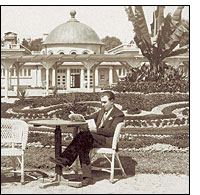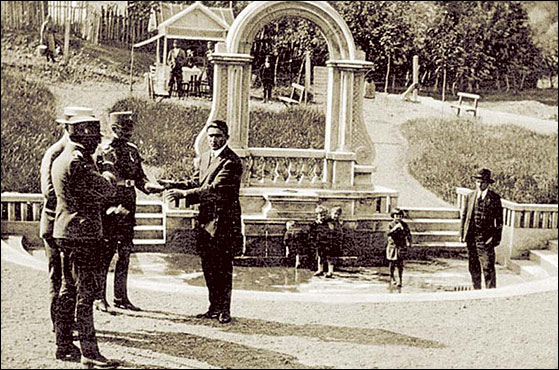|
History
 The history of exploitation of mineral waters in Vrnjci goes back far into the past, in the time when this region was inhabited by the Celtic tribe Scordiscs. After the Roman invasion of the Balkans in the last centuries BC and in the first few centuries AD, mineral waters were used for drinking and bathing, what is proved by a Roman spring discovered during the process of seizing of the hot mineral water in Vrnjci in 1924, and by a great number of coins bearing figures of Roman emperors. It is very likely that the newly settled Slavs in the Middle Age were aware of the healing properties of the Vrnjci waters. After the Turkish invasion of the Balkans there are almost no data of the Vrnjci mineral waters being used, except a few unreliable legends saying that the Turks, towards the end of their reign, were aware of the healing properties of the water, and that they used it as such. The history of exploitation of mineral waters in Vrnjci goes back far into the past, in the time when this region was inhabited by the Celtic tribe Scordiscs. After the Roman invasion of the Balkans in the last centuries BC and in the first few centuries AD, mineral waters were used for drinking and bathing, what is proved by a Roman spring discovered during the process of seizing of the hot mineral water in Vrnjci in 1924, and by a great number of coins bearing figures of Roman emperors. It is very likely that the newly settled Slavs in the Middle Age were aware of the healing properties of the Vrnjci waters. After the Turkish invasion of the Balkans there are almost no data of the Vrnjci mineral waters being used, except a few unreliable legends saying that the Turks, towards the end of their reign, were aware of the healing properties of the water, and that they used it as such.
After the liberation from the Turks, in the beginning of the 19th century, the duke Milosh hired a saxon geologist baron Herder to examine mineral springs in Serbia, so the hot mineral water was also examined. There are reliable data that the local residents of the village Vrnjci and the surroundings had been using hot mineral water for cure; it was also used for bathing and drinking by Janja, the bishop from Zicha. However, the history of the modern spa in Vrnjci is related to the year 1868, when the Krusevac prefect Pavle Mutavdzich with a few benefactors and distinguished people from Krushevac, Karavnovac (Kraljevo) and Trstenik established the Founding Endowment Association of Hot Mineral Water in Vrnjci. In the same year, the process of seizing two hot mineral springs was performed, whereby water was channeled and the use was made possible. Building of spa facilities, especially baths, also began.

Next year, 1869, the first season, justified the establishing of such an association and showed the future possibilities of the new spa. After a few years of stagnation, due to the lack of resources for building a sanatorium, and also due to the carelessness of the state, in the 1880s, when Vrnjci Spa became state-owned, and especially after building the villa of the general Jovan Belimarkovich, deputy of the king Alexandar Obrenovich, Vrnjci Spa begins to develop into a modern medical establishment.
In 1885, People’s Tavern, owned by Kosta Petrovich – Rakica, started to work as a real catering facility. Enterprising people from surrounding towns erect their villas and boarding houses, the central spa zone is being arranged, and in mid nineties the first regulation plan of Vrnjci Spa was made. The number of visitors grew bigger and bigger every year. Significant rise of the spa was experienced in the years before the Balkan wars. Vrnjci Spa then got a great number of modern boarding houses, a new bath was built, one cinema was open, and for the construction of another one the preparations were made. Several spa physicians were practicing. Just before the wars, the railway Stalach – Pozega was constructed. It passed near Vrnjci Spa, so the Spa got good traffic connections with most big towns in Serbia.
Stagnation affected Vrnjci Spa during the wars from 1912 to 1918. In 1915, there were several allied hospitals installed in the Spa boarding houses and resorts. After the First World War, a sharp rise was recorded, the climax of which was reached towards the end of the 1930s. Enthusiasm didn’t fall off even in the years of the recession: modern villas were erected, sanatoriums (St George, Zivadinovich), a great seizure of the hot mineral spring was performed in 1924/1925, a modern bath was erected, regulation of the Vrnjci river was performed, the Spa parks were extended and arranged, roads were built, waterworks and sewage system was extended. According to the 1933 census, in Vrnjci Spa there were 133 handicraft and commercial shops. Culture was also developing very fast, village fairs were organized, as well as music concerts, renowned theatres played as guests. Tourist association Goch was established and after the Bill on Spas had been adopted, a strict categorization of boarding houses and villas was performed. There were 257 such houses, according to the inventory of 1935. That year 28 080 guests visited the Spa, which was more than in any other tourist resort in Yugoslavia. After the Second World War, the profile of guests was changed: now the state sends patients to be cured, the level of service dropped, a great number of exclusive spa resorts was not used any more. A renewed rise of Vrnjci Spa happens again in the 1950s and 1960s, when there was a greater number of visitors and new resorts were built. The greatest boom was in 1980s – almost 200 000 visitors and two million tourist days.
|
|
|
History
Roman Spring
Geographical position
Video
GALLERY 
Health Tourism
Climate
Timetable
Accomodation
City Map
Parks
Springs
Culture
Churches
Bridge of Love
Entertainment
Sports
Sports clubs
Excursion
Food
Pizza, Cafes
Services
Trade, handicrafts
Important Phones
Calendar of Events
|